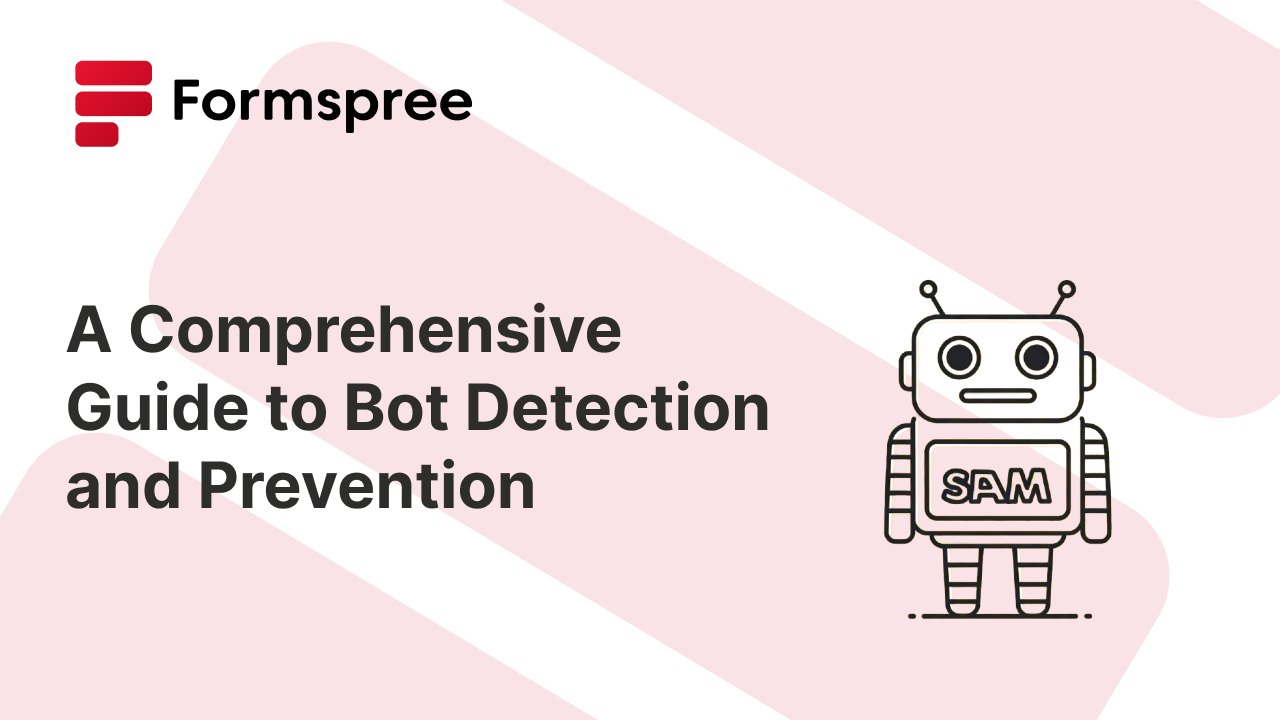A Comprehensive Guide to Bot Detection and Prevention
Learn bot detection technique and explore effective prevention strategies and mitigation measures to minimize the impact of bot activity on your website

If you’re gonna beat the bots, first you gotta know what it’s like to be a bot. Bots—those tireless, efficient, and often invisible entities—operate in the shadows of the internet, performing tasks with a level of speed and precision that humans can’t match. But despite their digital dexterity, bots follow a surprisingly simple structure. At its core, a bot is driven by a task, guided by instructions, and equipped with interaction abilities that allow it to navigate and manipulate the online world.
Bots come in all shapes and sizes, from basic scripts that perform repetitive actions to sophisticated programs that can mimic human behavior almost perfectly. Some bots are meant to be benign, automating routine tasks like scheduling posts on social media or crawling websites to index content for search engines. However, many bots are designed with more malicious intentions, making them a big threat to online security.

Gemini’s interpretation of a “fun illustration of a spam bot”.
So, why do bots exist? The motives behind bot activity are as varied as the bots themselves. Financial gain is a major driver, with bots engaging in activities like ad fraud, stealing credit card information, or executing phishing schemes. Others are focused on data harvesting, scraping email addresses and personal information to fuel spam campaigns. Some bots are simply tools of disruption, overwhelming servers with traffic to cause downtime and loss of revenue. In the competitive world of business, bots can also be used to gather intelligence, such as pricing data or customer reviews, giving their operators an edge in the market. Additionally, bots are often employed to manipulate online content, inflating views and likes, or spreading misinformation to sway public opinion.
As bots become more complex, it becomes more and more important to protect yourself from their impact. In this guide, you’ll learn about the anatomy of bots, the reasons behind their existence, and the growing sophistication that makes them such a tough opponent. We’ll explore the most effective bot detection techniques and strategies to prevent bot attacks and discuss how to mitigate the impact if your website is targeted.
Understanding Bot Detection Techniques
For effective bot detection, it’s important to recognize their strengths and weaknesses. Bots are great at executing repetitive tasks with speed and precision, but they often fail when faced with unpredictability, such as nuanced human behavior or complex challenges. Understanding this is important for spotting bot activity, as it allows you to implement detection methods that exploit these weaknesses.
One of the primary bot detection tools is behavioral analysis. This method involves examining user actions and patterns to distinguish between human and bot behavior. For example, bots might visit a large number of pages in rapid succession or display erratic mouse movements that don’t correspond to human behavior. By monitoring these patterns, you can identify unusual activity that suggests bot involvement.
Another powerful tool is the use of honeypots. Honeypots are decoy elements embedded within your website, specifically designed to attract and trap bots. These traps can be hidden links, form fields, or other interactive elements that legitimate users would never encounter or interact with. When a bot engages with these honeypots, they track and log the interaction, allowing you to monitor the bot’s behavior and take appropriate action.
Challenge-response tests, such as CAPTCHAs, are another widely used method for filtering out bots. These tests require users to perform tasks that are easy for humans but difficult for bots, like identifying objects in images or solving puzzles. While these tests can be effective, it’s essential to balance security with user experience, as overly complex challenges can frustrate legitimate users.

Most simple bots are known to struggle against CAPTCHAs
IP address tracking is a method that involves analyzing the origin of traffic to identify suspicious patterns associated with bots. Bots often operate from known malicious IP addresses or exhibit behavior such as frequent requests from a single IP in a short timeframe. By monitoring and blocking these IPs, you can prevent bots from accessing your site.
User agent analysis is another technique that examines the software and browser information sent by users to detect anomalies. Bots often attempt to mimic real browsers but may lack the sophistication to do so convincingly. By analyzing user-agent strings, you can identify and filter out these imposters.
For a more secure setup, it’s often beneficial to combine multiple detection techniques. By layering these methods, you can create a more comprehensive bot detection system that is harder for bots to evade.
Building Robust Bot Prevention Strategies
When it comes to preventing bot attacks, the key is to implement a multi-layered approach that not only stops bots in their tracks but also minimizes the impact on legitimate users. A well-rounded bot prevention strategy puts together several bot detection solutions that work together to create a robust defense.
One of the most effective strategies is Rate limiting, which restricts the number of requests a single IP address or user can make within a specific timeframe. By setting thresholds on how often a user can access certain parts of your website, you can effectively throttle the rapid-fire requests typical of bots. This method not only deters bots but also ensures that your server resources are not overwhelmed by excessive traffic.
Captcha implementation is another essential component of bot prevention. By requiring users to complete challenges that are easy for humans but difficult for bots, you can filter out a significant portion of automated traffic. However, it’s important to design these challenges thoughtfully to avoid frustrating legitimate users. For instance, using more modern captchas like reCAPTCHA, which leverages user behavior and machine learning to distinguish between humans and bots, can provide a better user experience.
Login throttling is particularly crucial for protecting sensitive areas of your website, such as login pages. By limiting the number of login attempts a user can make in a short period, you can thwart brute-force attacks where bots try to guess passwords by rapidly submitting different combinations.
For more advanced protection, setting up Web Application Firewalls (WAFs) can be highly effective. WAFs act as a filter between your website and incoming traffic, blocking malicious requests before they reach your servers. They are particularly useful in detecting and blocking bot traffic based on patterns and behaviors that indicate automated activity.
Finally, implementing two-factor authentication (2FA) adds an additional layer of security, especially for critical actions like logins or financial transactions.
Even if a bot manages to obtain a user’s credentials, 2FA requires a second form of verification, making it significantly harder for bots to succeed.
By combining these strategies, you can create a robust defense that not only prevents bots from infiltrating your systems but also maintains a smooth and secure experience for your legitimate users.
Mitigating the Impact of Bot Attacks
Even with the best prevention strategies in place, it’s possible that bots might still infiltrate your systems. When this happens, having a plan to mitigate the impact of bot attacks is important to minimize damage and ensure continuity.
One of the first steps in mitigation is traffic filtering. By implementing rules that automatically block suspicious IP addresses or user agents, you can quickly reduce the number of malicious requests reaching your server. This is especially effective against Distributed Denial of Service (DDoS) attacks, where bots flood your server with traffic in an attempt to overwhelm it. By filtering out known bad actors or limiting the rate of requests from certain IPs, you can maintain your website’s availability even under attack.
Content caching is another useful strategy for handling bot traffic well. By caching frequently accessed content, you can significantly reduce the load on your server during an attack. When bots flood your site with requests, serving cached content instead of dynamically generating pages can prevent your servers from being overwhelmed. This approach not only mitigates the impact of an attack but also ensures that legitimate users can still access your site without significant delays.
Real-time monitoring plays a critical role in identifying and responding to bot attacks as they happen. By continuously monitoring traffic and user behavior, you can detect unusual patterns that indicate an ongoing attack. Real-time alerts allow your security team to respond quickly, blocking malicious traffic and implementing additional defenses as needed.
Finally, having a well-defined incident response plan is essential. This plan should outline the steps to take when a bot attack is detected, including how to communicate with stakeholders, assess the damage, and restore normal operations. A swift, organized response can minimize downtime and reduce the financial and reputational impact of an attack.
By implementing these mitigation strategies, you can not only defend against bot attacks but also ensure that your website remains resilient, even in the face of determined adversaries.
Tools and Resources for Enhanced Security
To effectively combat the growing threat of bot attacks, leveraging the right tools and resources is essential. A well-equipped security toolkit not only enhances your defenses but also streamlines the process of detecting, preventing, and mitigating bot activity.
One of the most powerful resources at your disposal is cloud-based security solutions. Services like Cloudflare, Akamai, and AWS Shield offer comprehensive protection against bot attacks by providing features such as DDoS mitigation, Web Application Firewalls (WAFs), and real-time threat intelligence. These platforms continuously monitor global traffic patterns, enabling them to identify and block malicious bots before they reach your site. Their scalability also ensures that your website remains protected, regardless of the attack’s magnitude.
For developers and security professionals looking for more customizable options, open-source bot detection libraries can be invaluable. Tools like BotD by FingerprintJS and Fail2Ban offer flexibility and control over how bot detection is implemented within your environment. These libraries can be integrated directly into your applications, allowing you to tailor the detection mechanisms to your specific needs. Open-source solutions also benefit from community contributions, ensuring that they remain up-to-date with the latest bot tactics and techniques.
Staying informed about emerging bot threats and evolving attack vectors is also crucial. Online resources, such as OWASP’s Automated Threats to Web Applications project and industry blogs, provide up-to-date information on the latest bot trends and best practices for defending against them. These resources often include detailed case studies, tool recommendations, and expert insights, helping you stay ahead of potential threats.
By combining these tools and resources, you can build a robust, adaptable security framework that not only defends against current bot threats but is also prepared to tackle future challenges. Whether you’re leveraging cloud-based solutions for comprehensive protection or integrating open-source tools for a more hands-on approach, having the right resources in place is key to maintaining a secure online presence.
Formspree: Your Ally Against Bot Attacks
When it comes to securing your forms from bot attacks, Formspree offers a user-friendly and effective solution. Designed with simplicity and security in mind, Formspree automatically handles bot detection and mitigation, allowing you to focus on your core business without worrying about complex configurations.
Formspree’s built-in spam protection features are particularly powerful. By filtering out malicious form submissions, Formspree ensures that only legitimate user data reaches your inbox. This not only reduces the clutter of spam emails but also protects your systems from potential threats embedded in malicious submissions. The platform uses a combination of techniques, including CAPTCHA and honeypots, to distinguish between human users and bots, providing a robust first line of defense.
Additionally, Formspree’s seamless integration into your existing workflows makes it an ideal choice for developers looking to implement secure forms quickly. Whether you’re dealing with contact forms, sign-up forms, or support requests, Formspree simplifies the process while enhancing security. By choosing Formspree, you can ensure a secure, streamlined form-handling experience that protects your users and your business from the growing threat of bot attacks.